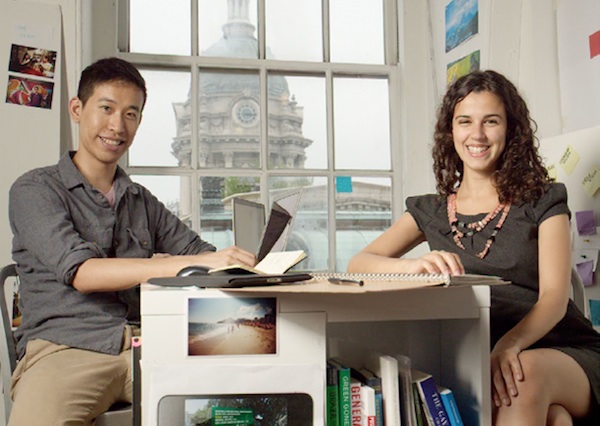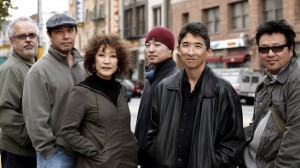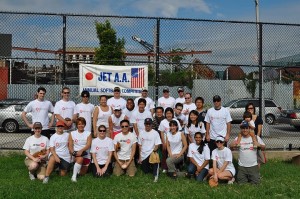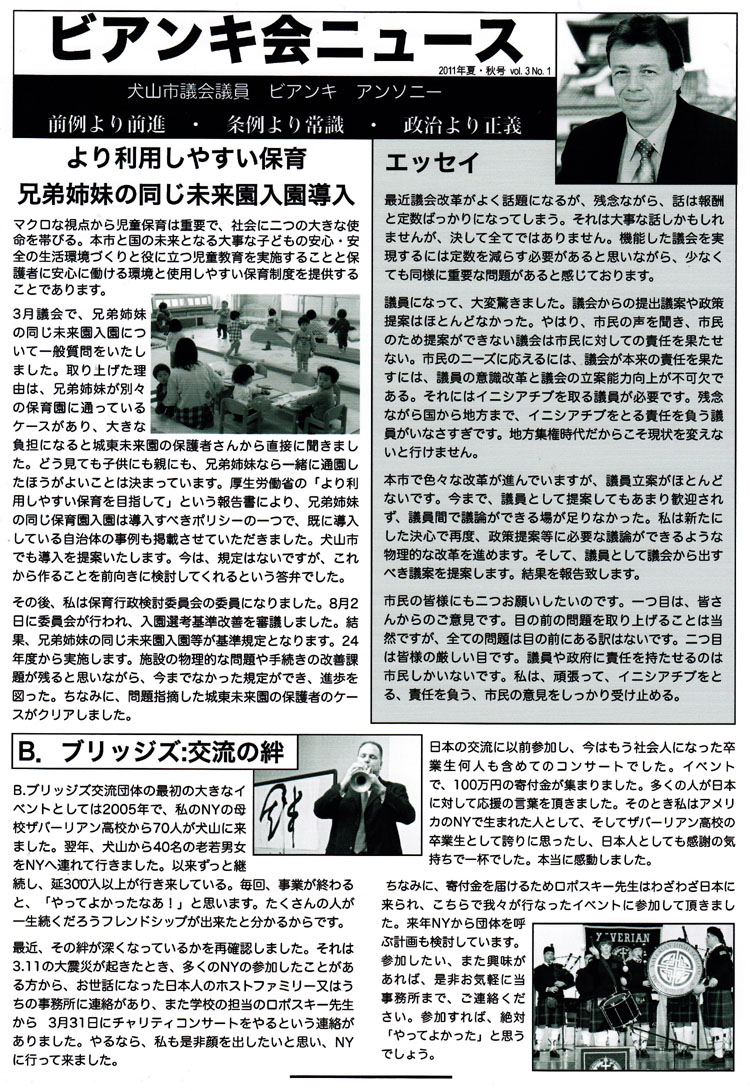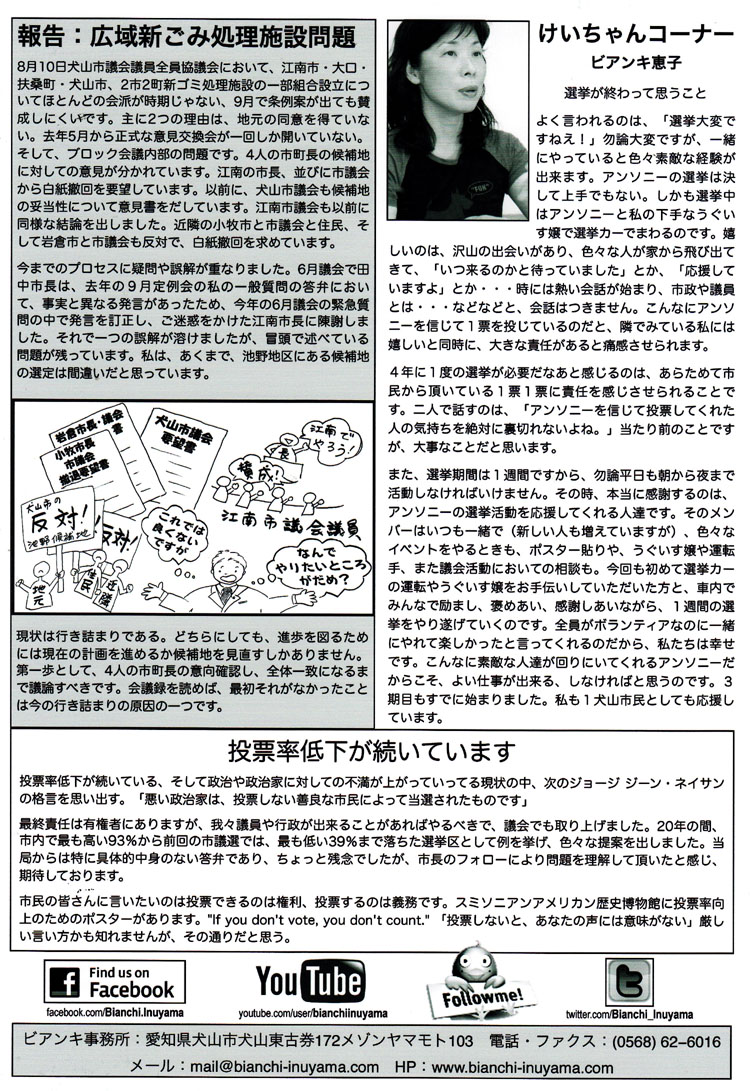JQ Magazine: JQ&A with Author/JET Alum James Kennedy on the 90-Second Newbery Film Festival

"As for how being on JET has influenced my writing—definitely, a lot of the fantastical world in my book 'The Order of Odd-Fish' is inspired by what I saw and experienced in Japan." (Courtesy of James Kennedy)
By Renay Loper (Iwate-ken, 2006-07) for JQ magazine. Renay is a freelance writer and Associate Program Officer at the Japan Foundation Center for Global Partnership. Visit her blog at Atlas in Her Hand.
James Kennedy (Nara-ken, 2004-06), author of the acclaimed young adult novel The Order of Odd-Fish, will be curating the 90-Second Newbery Film Festival at the New York Public Library on Nov. 5 and with the Harold Washington Library in Chicago on Nov. 16.
Named after John Newbery (thought to be the founding father of children’s literature), the Newbery Award is considered the highest regarded honor given to the author of the most distinguished contribution to American children’s literature, and the American Library Association has awarded it every year since 1922. James took a moment to tell us a little about the festival, curating, and his path as an author.
What is the premise of the festival?
[It is a contest, or challenge of sorts] open to anyone, to make a video that compresses the story of a Newbery Medal (or Honor)-winning book into 90 seconds or less. No book trailers! It has to be the entire story. For it turns out that any book, no matter how worthy and somber, becomes pleasingly ludicrous when compressed into 90 seconds. The goal is comedy.
In a previous JETwit posting, you mentioned three award winners who wrote about Japan and the Japanese that no one has tackled yet. Why do you think that is?
Only because the books aren’t as famous—people are naturally inspired to make movies of books they’ve already read and loved. Everyone has heard of Newbery Medal winners like A Wrinkle in Time by Madeleine L’Engle, The Graveyard Book by Neil Gaiman, or Bridge to Terabithia by Katherine Paterson.
The three Japan-related books that won Newbery Medals or Honors—Kira-Kira by Cynthia Kadohata, Heart of a Samurai by Margi Preus, and Commodore Perry in the Land of the Shogun by Rhoda Blumberg—are just not as well-known, and so it’s less likely someone would be moved to make a video. Their oversight is your opportunity! (To make it more interesting, you could even do it in Japanese and add subtitles!)
If you had to give one word of advice to entrants, what would it be?
Don’t merely recap the book. Transform the story! Either in style or substance. Some great examples of successful 90-Second Newbery entries are this full-scale musical version of The 21 Balloons, or this shadow puppet version of Where the Mountain Meets the Moon.
As I mention in the contest rules, it’s fun to switch up the genre style, like doing Charlotte’s Web in the nightmarish style of David Lynch’s Eraserhead. Or even cross two Newbery books: how about the rodents of Mrs. Frisby and the Rats of Nimh fight their counterparts in The Tale of Despereaux? Rat fights make for gripping cinema! Basically, make it funny. The deadline for entries is Oct. 17.
JET alum Lee-Sean Huang in Fast Company, recruiting alumni interested in design for social innovation for new MFA program
JET alum and JETwit webmaster Lee-Sean Huang (Oita-ken, Nakatsu-shi, 2003-2006) recently appeared in the Fast Company article “An MFA Degree For Designers Who Want To Change The World” by Michael J. Coren.
So you want to change the world? Cynics may send you off to Wall Street or a white-shoe law firm. Those with gumption will look for another way. The new Master’s of Fine Arts in Design for Social Innovation has opened its doors just for them.
“We’re adamant this not be a program where people sit in a classroom and talk about how great it’s going to be when they go out and change the world,” says program chair Cheryl Heller at the School of Visual Arts (SVA) in New York, and a board member of PopTech. “It is helping designers go beyond self-expression, which is how most designers are taught, and how to put [design] into practice to create a change.”
Read the full Fast Company article here.
Lee-Sean, a faculty member in the department, is reaching out to the JET community and encouraging returning JETs and alumni to apply to the MFA Design for Social Innovation program. The program is for applicants from a broad range of backgrounds with an interest in design and social innovation, and not just those with college degrees or prior professional experience in design. Email leesean@purpose.com with inquiries, and apply here. The deadline for applications is January 15, 2015 for Fall 2012 enrollment.
Photo: Lee-Sean with fellow MFA Design for Social Innovation faculty member Alessandra Orofino.
JET alum author Bruce Feiler’s latest NYTimes column
September 23, 2011
By BRUCE FEILER
I RECENTLY attended a chaotic, kid-friendly gathering at the home of a friend. On my way to the bathroom to seek some solace, I decided to indulge in one of my favorite antisocial activities: scrutinizing someone else’s bookshelf. For a veteran sleuth, a bookshelf can offer a trove of insights worthy of any Freudian’s couch. Does a person alphabetize the books or clump them? Do they arrange their books by genre, order in which they were purchased, or color? Are these books unopened hardcovers or dog-eared paperbacks?
I was several minutes into my investigation (Bill Clinton’s memoir; “The DaVinci Code”), when I had a heart-sinking realization: Read More
Coverage of Anderson family visit to Ishinomaki and dedication of “Taylor’s Library”
************
Thanks to Andy Anderson, father of Taylor Anderson, for sharing this information:
- NHK coverage: “Bereaved Parents Bond” – http://www3.nhk.or.jp/nhkworld/english/movie/findex_japan.html (Though my computer is telling me “Missing Plug-in” which is preventing me from watching the video. If you get it to work on your computer, please share any helpful comments.)
- Translations of various Japanese newspaper articles, provided by a friend for the Andersons:
*************
Daily Yomiuri
An American Teacher Falls Victim to the Tsunami
Our Daughter’s Best-Loved Books to Her Students
Family of the Deceased Donates to Ishinomaki
The family of Taylor Anderson (then 24), an American woman engaged in English language instruction at elementary schools in Ishinomaki City, Miyagi Prefecture before falling victim to the tsunami, visited Mangokuura Elementary School in Ishinomaki on the sixth and presented the school with 40 books. Anderson’s father, Andy (54) addressed 60 students saying, “Find your dreams and live. That is what my daughter did.”
The woman of whom he spoke was Virginia-native assistant language teacher Taylor Anderson. Anderson came to Japan in 2008 and taught English at elementary schools in Ishinomaki City. On the day of the earthquake, she watched over the school children from Mangokuura Elementary to see that they had evacuated before heading back for home. She was swallowed up by the tsunami waves.
Donated on the sixth was a collection dubbed “Taylor’s Library,” 40 volumes in total. Anderson’s personal favorites were included in the collection, which was purchased using money from a fund established by the surviving parents and Anderson’s alma mater.
At the dedication ceremony held at Mangokuura Elementary, Andy shared memories from Taylor’s childhood. “Once she started reading, she wouldn’t stop. She read and expanded her imagination.” He also shared the power of reading that brought her dream of becoming a bridge connecting Japan and America to fruition.
Kaito Hikiji (12), a student representative who expressed thanks to Andy and family in English, said, “Ms. Anderson told us about Harry Potter, and it was easy to feel close to her. We will think of these books as Ms. Anderson and treat them with care.”
The family plans to donate books in succession to each of the six schools at which Anderson taught.
*************
(Not sure which publication this is from.)
“Find your dreams and live.”
An Expression of Love through Books
Surviving Family of the American ALT who Fell Victim to the Earthquake Disaster Donates Picture Books
The family of Taylor Anderson (then 24, U.S.), the Ishinomaki City assistant language teacher (ALT) who perished in the aftermath of the Great East Japan Earthquake, donated books Anderson read as a child to a local elementary school as “Taylor’s Library” on the sixth of this month.
In attendance at the dedication ceremony held at Mangokuura Elementary School in Ishinomaki City were 64 sixth-grade students (then fifth graders) who had class with Anderson on the day of the earthquake. Father Andy (53) greeted them saying, “It will make us so happy if you will read these books, find your dreams, and live on.”
“Ms. Anderson was nice. I want to read these books with care,” said Moeka Abe (12), a student of Anderson’s.
Donated were approximately 40 volumes comprising children’s literature and picture books newly-purchased by Andy and family. The books are now kept on a bookshelf built by local carpenter Shinichi Endo, who currently resides in temporary housing in Higashi Matsushima City. Endou lost his three children to the tsunami. His eldest son and second daughter were both students of Anderson.
“I built the bookshelf while picturing Ms. Anderson’s cheerful spirit. I felt that this job was my opportunity to start looking forward in life,” he explained.
Anderson first came to Japan in 2008. Besides Mangoku Elementary, she instructed students in English at one kindergarten and a total of six elementary and junior high schools in Ishinomaki City. “Taylor’s Library” will also be donated to these institutions.
On the day of the earthquake, Anderson saw that the students from Mangoku Elementary evacuated to nearby Mangoku Junior High and was on her way home on her bicycle when she was swept away by the tsunami.
*************
Asahi Shimbun
Students of our Daughter: Learn English through Books
“She loved to read as a child. I hope that you will all find your dreams in these books, too.” On the sixth, the family of Taylor Anderson (then 24), the American assistant language teacher who passed away in Ishinomaki City, Miyagi Prefecture on the day of the Great East Japan Earthquake, visited Mangokuura Elementary School where their daughter had taught and presented the school with 40 English-language books and a bookshelf. They have named it “Taylor’s Library.”
On the day of the earthquake, Anderson, along with other faculty, saw that the children had evacuated, and upon parting with them was hit by the tsunami.
“Had she lived, she would have been working for the people of Ishinomaki.” Anderson’s father, Andy (53), who resides in the state of Virginia, decided to donate books to the kindergarten and elementary and junior high schools—seven institutions in total—where his daughter taught.
The students who had class with Anderson on that fateful day greeted Andy and his wife, Jean (53), in English, saying, “Taylor’s class was fun. It made us like English.” Jean shared that her heart was warmed at the chance to stand in the place where her daughter once stood.
*************
By Justin Tedaldi (CIR Kobe-shi, 2001-02) and Vlad Baranenko (Saitama-ken, 2000-02) for JQ magazine.
Presented by The Playwrights Realm, the drama Crane Story stars Angela Lin (a veteran of JET alum Randall David Cook’s Sake with the Haiku Geisha) as Cassis, a young Japanese American on an odyssey to rescue her brother’s soul from the land of the dead.
Written by Jen Silverman and directed by Katherine Kovner, Crane Story runs through Oct. 1 at the Cherry Lane Theatre in New York’s Greenwich Village. Here’s what JQ‘s critics had to say at a Midtown diner after a recent performance.
Justin Tedaldi: What were your thoughts about the production?
Vlad Baranenko: Given the limited resources that they have being Off-Broadway, they did a very good job with the imagery and the special effects.
JT: I really liked the way the creative team put everything together with the scenery and the costumes, especially the sound effects. There’s a raised wooden stage where most of the action happens, and at the very beginning they describe rain, but you see the rest of the cast drumming their fingers on the stage, which creates the illusion of falling rain. Very creative ways of getting around the limitations that come with being an Off-Broadway production.
VB: I agree on that. The cast obviously remembered their lines really well. It didn’t seem forced, actually; very natural. In that regard, I give them high marks.
JT: I’m reading here that the actor who plays Ishida, Louis Ozawa Changchien, appeared with Adrien Brody, Topher Grace and Laurence Fishburne in the movie Predators.
VB: He looks like someone who’s got some pretty good experience under his belt. He comes off as very authentic in the way he acts, and that’s one of the first things that I noticed.
Justin’s Japan: Hiroshima lends its divine sound to NYC Japan benefit concert
By JQ magazine editor Justin Tedaldi (CIR Kobe-shi, 2001-02) for Examiner.com. Visit his page here for related stories.
A staple of the Los Angeles jazz scene since 1974, Hiroshima returns for an East Coast engagement tonight (Sept. 21) to headline a Japan relief benefit concert with special guest stars at New York’s B.B. King Blues Club & Grill.
The only Asian American band to have been nominated for a Grammy, the group’s most recent album, 2009’s Legacy, celebrates Hiroshima’s 30th anniversary of recording and serves as a re-visitation of songs (like the easy listening favorite “Roomful of Mirrors” and ’80s hit single “One Wish”) from the band’s first decade.
Led by original members Dan and June Kuramoto, the group proved itself a musical chimera from the start with its self-titled debut, mixing elements of jazz, pop, and R&B with traditional Japanese instruments. Dan has remarked that at the time in America, music was the only outlet of cultural diversity available, and the resulting disc was a pioneering voice in the world music movement that followed.
For the complete story, click here.
Justin’s Japan: Japan Society Remixes a Greek Masterpiece with ‘Medea’
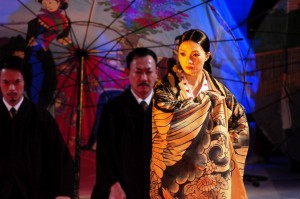
Micari stars in Satoshi Miyagi's production of 'Medea,' running Sept. 23-25 at New York's Japan Society.
By JQ magazine editor Justin Tedaldi (CIR Kobe-shi, 2001-02) for Examiner.com. Visit his page here for related stories.
Looking for an Eastern take on a Western classic? Japan Society kicks off its fall 2011/spring 2012 performing arts season with the Shizuoka Performing Arts Center (SPAC)’s production of Medea with a three-performance engagement from Sept. 23-25.
Directed by SPAC artistic director Satoshi Miyagi, the performance makes its North American premiere as a visual feast on the scale of a kabuki play. Set in 19th century Japan among the nation’s imperialist, gender-divided late Meiji era, this bold reinterpretation of Euripides’ evergreen features a company of 19 presented in Miyagi’s distinct bunraku puppet theater-inspired style accompanied on stage by live music.
Performed in Japanese with English subtitles, this stunning and internationally acclaimed production has traveled to 20 cities and 11 countries since its premiere in 1999. It also marks the return of SPAC to Japan Society, where the troupe mounted productions of Electra and Oedipus Rex during national tours for both.
For the complete story, click here.
JQ Magazine: Art Review – ‘Fiber Futures: Japan’s Textile Pioneers’ at Japan Society
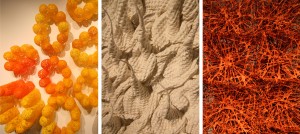
From left to right: 'Feel the Wind' (2010), by Fuminori Ono; 'Birth' (2011) by Hitomi Nagai; 'Su no hana' (Nest Flowers) (2011) by Takaaki Tanaka. (Vlad Baranenko)
By Vlad Baranenko (Saitama-ken, 2000-02) for JQ magazine. Vlad is an avid photographer.
Opening this week at New York’s Japan Society is the exhibit Fiber Futures: Japan’s Textile Pioneers, which showcases the works of Japanese textile masters and explores the ever evolving relationship between traditional fabric manufacturing and the uses of unconventional technology and materials to create awe-inspiring works of art. To commemorate the opening of the gallery and the designation of the Japan Society building as a city landmark, a special preview event was held on Sept. 14 with many of the artists in attendance along with an exhibition walkthrough from gallery director Joe Earle.
Originally conceived in 2007, the project received approval following this year’s devastation in Japan, and is jointly presented by Japan Society and the International Textile Network Japan in collaboration with Tama University. According to Japan Society, the collection of 35 works on display was thoroughly selected by a special committee to showcase the work of 30 contemporary masters of a movement originally envisioned in the 1950s to “reflect the fecundity of the Japanese artistic tradition and ingenuity.” Since many of the pieces had to make a long journey from Japan to New York, unique containers had to be meticulously designed for each piece to preserve the artist’s intended presentation and allow the viewer to fully appreciate each work.
To simply describe the collection as a stunning example of creativity and the profound Japanese insight into the coexistence of nature and man would not be enough to credit the artists on display. The exhibition explores such themes as the passage of time and seasons just to name a few. While many of the works are composed of traditional materials such as silk and washi paper, modern materials such as stainless steel, vacuum deposited aluminum, and complex chemical dyes are also added to create three-dimensional enchanting expressions.
JQ Magazine: Photos from the 2011 JETAANY Softball Tournament
By Monica Yuki (Saitama-ken, 2002-04) and Pam Kavalam (Shiga-ken, 2007-09), the JET Alumni Association of New York (JETAANY)’s President and Secretary, for JQ magazine.
On Saturday, Sept. 10, The JET Alumni Association of New York (JETAANY) hosted its Annual Softball Tournament in Red Hook, Brooklyn. Joining the JETs for some friendly competition were Amnet, Docomo, Kintetsu, Mitsubishi, TV Japan, Quick USA, and Yusen. Despite some ominous looking clouds, the 175+ players and spectators enjoyed beautiful, rain-free weather. The daylong tournament was filled with many spectacular plays and great hits, and the event finished with an award ceremony and BBQ at a local bar to celebrate this year’s champion, Yusen. A big thank you to all the teams for coming out and for the tournament’s organizer (and JETAANY President) Monica Yuki!
View the tournament’s Picasa album here.
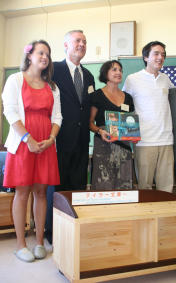 From the Kahoku Online Network:
From the Kahoku Online Network:
震災で犠牲の米国人ALT 志文庫に託す 遺族が絵本寄贈
http://www.kahoku.co.jp/news/2011/09/20110907t15011.htm
東日本大震災で亡くなった宮城県石巻市の女性外国語指導助手(ALT)テイラー・アンダーソンさん=当時(24)、米国出身=の遺族が6日、アンダーソンさんが子ども時代に読んだ本を「テイラー文庫」として市内の小中学校などに寄贈した。
同市万石浦小で行われた贈呈式には、震災当日に授業を受けた6年生(当時5年生)64人が出席。父親のアンディさん(53)が「本を読んで、夢を持って生きてくれたら幸せです」とあいさつした。授業を受けた阿部萌香さん(12)は「先生は優しかった。本は大切に読みたい」と話した。
寄贈されたのは、アンディさんらが新たに購入した英語の児童文学や絵本など約40冊。東松島市の仮設住宅で暮らす地元の木工作家遠藤伸一さん(42)が製作した本棚に収められている。
遠藤さんは子ども3人を津波で失い、長男と次女の2人が同市渡波小でアンダーソンさんの指導を受けていた。
遠藤さんは「明るく、元気なアンダーソンさんをイメージして作った。この仕事を機に、自分も前を向いて生きていこうと思った」と話した。
アンダーソンさんは2008年に来日し、石巻市では万石浦小のほか、市内の幼稚園1カ所と小中学校計5校で英語を指導。「テイラー文庫」はこれらの幼稚園、小中学校にも寄贈される。
アンダーソンさんは震災当日、万石浦小から近くの万石浦中に児童を避難させた後、自転車で帰宅する途中に津波にのまれたとみられている。
2011年09月07日水曜日
And here’s a very rough summary in English:
“American ALT, lost in the disaster, is memorialized in a library; Family donates picture books”
The reading corner / library contains copies of books that Taylor read growing up. The dedication ceremony was held at Mangokuura Elementary, with 64 of Taylor’s former 5th grade students attending. There are 40 books in the shelves, which were built by Endo-san, a woodworker who lost his three children to the tsunami – two of whom were Taylor’s students at Watanoha Elementary School. Endo-san said that he built the shelves thinking about how bright and genki Taylor was, and that this project helped him to move forward with his own life, too. Andy Anderson told the students that he will be happy if they read books and hold on to their dreams in life.
Slate.com series: “Can Japan Recover?”
There’s an excellent ongoing series on Slate.com titled “Can Japan Recover?” by Daisann McLane as she travels through various areas of Tohoku. McLane is traveling and writing about Japan as a guest of the Japan National Tourism Organization (JNTO).
“I’m exploring recovering Japan as a guest of the Japan National Tourism Organization. Tourism here dropped through the floor in the first three months after what’s now being called the “Triple Disaster”—earthquake, tsunami, Fukushima. The tourism board was so eager for upbeat stories they offered to send me anywhere I wanted over the course of a week. I emailed them a decidedly non-upbeat itinerary: Sendai, Fukushima, Tokyo. To my surprise, and to their credit, they said no problem. A few weeks later, in July, I was on a Shinkansenspeeding north from Tokyo to Sendai.”
To read more of McLane’s writing about Japan on her travel blog, go to www.therealtravelblog.com.
JQ Magazine: DVD Review — ‘Live from Tokyo’ Explores Music’s Japanification
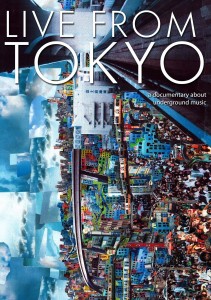
"What makes this film so unique is how the visuals compliment the subject matter. The music becomes more visceral when scenes from Tokyo’s fluorescent nightlife are flashing on the screen." (Good Charamel Records)
By Sam Frank, an ALT who taught English in Hiraizumi-Cho, Iwate-ken, from 2002-04 and worked in Shirahama-cho, Wakayama-ken as a JET from 2004-06, for JQ magazine. He currently manages the New York division of UnRated magazine and works as a project manager/Web producer at Arrow Root Media.
When it comes to cultural diversity, Japan has always been a borrower. Their entire writing system, known as kanji, is made up of Chinese characters; the country’s most popular sport is baseball, America’s pastime; and South Korean television dramas get all the top ratings. Japan’s music scene is no different. In Live from Tokyo, American director Lewis Rapkin takes us on a kaleidoscopic journey through Tokyo’s bustling underground music scene. Set within the backdrop of the modern Japanese megalopolis, the film explores Tokyo’s eccentric music culture, and how a combination of global information, media-saturated urban areas, and cutting edge innovation has impacted it.
“Since the 2000s, when the Internet became widely used, the number of people listening to underground music has been growing,” explains Murata, lead singer of the band Kuruucrew, during one of the film’s many fascinating interviews. There are many facets to Japan’s underground music scene, and Rapkin captures them beautifully. Early on in the film we learn how MP3s and digital downloads have altered Japan’s musical landscape. TokyoGigGuide.com’s Craig Eaton describes how you can now “get albums online, whereas in the past you’d have to wait until it came to your country or order it, and wait for it to come in the mail.” With a simple click, you can now access Japanese underground artists such as Shugo Tokumaru, Sexy-Synthesizer, and Sajjanu.
When we’re not learning about the underground scene through band interviews, Rapkin gives us an all-access pass to the bands as they perform on stage. Juxtaposed with time lapses of Shibuya’s nightlife, first person views from train lines, and kaitenzushi conveyor belts, we hear punk rock, J-pop, heavy metal, traditional Japanese music, and various synthesizer-based experiments.
For the complete story, click here.
Sake World e-Newsletter by John Gauntner (August – September 2011)
 The August – September 2011 issue of the Sake World e-newsletter by JET alum and the leading non-Japanese sake expert in the world, John Gauntner (a.k.a. “The Sake Guy”), is now available online.
The August – September 2011 issue of the Sake World e-newsletter by JET alum and the leading non-Japanese sake expert in the world, John Gauntner (a.k.a. “The Sake Guy”), is now available online.
Go to John’s Sake World website for more information as well: www.sake-world.com
“A Perspective on Helping Japan Disaster Victims” by ex-JET Jeannie McKinney
This article titled “A Perspective on Helping Japan Disaster Victims“ recently appeared on the CleanEnergy.org website, written by Jeannie McKinney (Hokkaido, 2010-11) who is currently doing an internship for the Knoxville, TN office of the Southern Alliance for Clean Energy (SACE).
Link to original post: http://blog.cleanenergy.org/2011/08/30/helping-japan-disaster-victims/
Here’s an excerpt:
“Post-March 11th, the amount of willingness and enthusiasm, good will and generosity that came from abroad as well as at home, was honestly overwhelming. I was living in a small town in Hokkaido, the northernmost island and prefecture of Japan, at the time of the disaster, in an area that experienced nothing but a few tremors and shakes. But somehow, my community of 13,000 generated so many donation packages within the first few weeks after the disaster that our three little post offices had trouble handling the increased mail traffic. Instead, postal workers had to set out collection bins in their lobbies for the Japan Red Cross to come and pick up on their own.”
***********
“The problem is that there is only so much individuals can do on their own, without any direction or instruction from organized groups – especially without advice from the country’s government. Post-Katrina, the biggest complaints here in the U.S. were the slow reactions of the local and federal government to respond. Though nonprofits and volunteer groups were first on the scene, there was only so much they could do without bureaucratic support.”
“The same can be said for Japan right now, both in disaster areas as well as radiation areas.”
Latest Newsletter from Councilman Anthony Bianchi
************
Here’s the newest newsletter from JET alum and Inuyama City Council Member Anthony Bianchi (Aichi-ken, Inuyama-shi, 1988-89):
***Page 1***
CLICK HERE for more JETwit posts about Anthony Bianchi.
Show off your translating skills! An English translation or summary of some or all of the above would be great if any readers are up for it. Full credit will be given!

